Evaluating the Role of Land Surface Moisture in Generating Asymmetrical Precipitation during the Landfall of Hurricane Florence (2018)
Abstract
1. Introduction
- How does atmospheric stability vary surrounding Hurricane Florence during landfall, and is it consistent with an asymmetrical precipitation distribution?
- How does land surface moisture affect the atmospheric stability and precipitation surrounding Hurricane Florence during landfall?
2. Materials and Methods
2.1. WRF Model
2.2. Observational Data
2.3. Noah Land Surface Model
2.4. Experimental Design
2.5. Comparisons among Experiments
3. Results
3.1. Track and Intensity Comparisons
3.2. Comparison of Control Simulation with Observations
3.2.1. Precipitation
3.2.2. Atmospheric Stability
3.2.3. Discussion
3.3. Altered Land Use Simulations
3.3.1. Precipitation
3.3.2. Atmospheric Stability
3.3.3. Water and Energy Budget
3.3.4. Discussion
4. Conclusions
Author Contributions
Funding
Institutional Review Board Statement
Informed Consent Statement
Data Availability Statement
Acknowledgments
Conflicts of Interest
References
- Stewart, S.R.; Berg, R. Tropical Cyclone Report: Hurricane Florence; National Hurricane Center: Miami, FL, USA, 2019.
- Paul, S.; Ghebreyesus, D.; Sharif, H.O. Brief Communication: Analysis of the Fatalities and Socio-Economic Impacts Caused by Hurricane Florence. Geosciences 2019, 9, 58. [Google Scholar] [CrossRef]
- Powell, M.D. Changes in the Low-Level Kinematic and Thermodynamic Structure of Hurricane Alicia (1983) at Landfall. Mon. Weather Rev. 1987, 115, 75–99. [Google Scholar] [CrossRef]
- Chan, J.C.L.; Liang, X. Convective Asymmetries Associated with Tropical Cyclone Landfall. Part I: F-Plane Simulations. J. Atmos. Sci. 2003, 60, 1560–1576. [Google Scholar] [CrossRef]
- Guo, Q.; Matyas, C.J. Comparing the Spatial Extent of Atlantic Basin Tropical Cyclone Wind and Rain Fields Prior to Land Interaction. Phys. Geogr. 2016, 37, 5–25. [Google Scholar] [CrossRef]
- Matyas, C.J. A Geospatial Analysis of Convective Rainfall Regions Within Tropical Cyclones After Landfall. Int. J. Appl. Geospat. Res. 2010, 1, 71–91. [Google Scholar] [CrossRef]
- Zhou, Y.; Matyas, C.; Li, H.; Tang, J. Conditions Associated with Rain Field Size for Tropical Cyclones Landfalling over the Eastern United States. Atmos. Res. 2018, 214, 375–385. [Google Scholar] [CrossRef]
- Corbosiero, K.L.; Molinari, J. The Effects of Vertical Wind Shear on the Distribution of Convection in Tropical Cyclones. Mon. Weather Rev. 2002, 130, 2110–2123. [Google Scholar] [CrossRef]
- Corbosiero, K.L.; Molinari, J. The Relationship between Storm Motion, Vertical Wind Shear, and Convective Asymmetries in Tropical Cyclones. J. Atmos. Sci. 2003, 60, 366–376. [Google Scholar] [CrossRef]
- Matyas, C.J.; Cartaya, M. Comparing the Rainfall Patterns Produced by Hurricanes Frances (2004) and Jeanne (2004) over Florida. Southeast Geogr. 2009, 49, 132–156. [Google Scholar] [CrossRef]
- Matyas, C.J. Quantifying the Shapes of U.S. Landfalling Tropical Cyclone Rain Shields. Prof. Geogr. 2007, 59, 158–172. [Google Scholar] [CrossRef]
- Atallah, E.; Bosart, L.F.; Aiyyer, A.R. Precipitation Distribution Associated with Landfalling Tropical Cyclones over the Eastern United States. Mon. Weather Rev. 2007, 135, 2185–2206. [Google Scholar] [CrossRef]
- Kimball, S.K. A Modeling Study of Hurricane Landfall in a Dry Environment. Mon. Weather Rev. 2006, 134, 1901–1918. [Google Scholar] [CrossRef]
- Shu, S.; Feng, X.; Wang, Y. Essential Role of Synoptic Environment on Rainfall Distribution of Landfalling Tropical Cyclones Over China. J. Geophys. Res. Atmos. 2018, 123, 11285–11306. [Google Scholar] [CrossRef]
- DeHart, J.C.; Houze, R.A. Orographic Modification of Precipitation Processes in Hurricane Karl (2010). Mon. Weather Rev. 2017, 145, 4171–4186. [Google Scholar] [CrossRef]
- Zhu, L.; Aguilera, P. Evaluating Variations in Tropical Cyclone Precipitation in Eastern Mexico Using Machine Learning Techniques. J. Geophys. Res. Atmos. 2021, 126, e2021JD034604. [Google Scholar] [CrossRef]
- Leroux, M.-D.; Wood, K.; Elsberry, R.L.; Cayanan, E.O.; Hendricks, E.; Kucas, M.; Otto, P.; Rogers, R.; Sampson, B.; Yu, Z. Recent Advances in Research and Forecasting of Tropical Cyclone Track, Intensity and Structure at Landfall. Trop. Cyclone Res. Rev. 2018, 7, 85–105. [Google Scholar] [CrossRef]
- Villarini, G.; Smith, J.A.; Baeck, M.L.; Marchok, T.; Vecchi, G.A. Characterization of Rainfall Distribution and Flooding Associated with US Landfalling Tropical Cyclones: Analyses of Hurricanes Frances, Ivan, and Jeanne (2004). J. Geophys. Res. Atmos. 2011, 116, D23. [Google Scholar] [CrossRef]
- Andersen, T.; Shepherd, M. Inland Tropical Cyclones and the “Brown Ocean” Concept. In Hurricanes and Climate Change; Collins, J.M., Walsh, K., Eds.; Springer International Publishing: Cham, Switzerland, 2017; Volume 3, pp. 117–134. ISBN 978-3-319-47594-3. [Google Scholar]
- Nair, U.S.; Rappin, E.; Foshee, E.; Smith, W.; Pielke, R.A.; Mahmood, R.; Case, J.L.; Blankenship, C.B.; Shepherd, M.; Santanello, J.A.; et al. Influence of Land Cover and Soil Moisture Based Brown Ocean Effect on an Extreme Rainfall Event from a Louisiana Gulf Coast Tropical System. Sci. Rep. 2019, 9, 17136. [Google Scholar] [CrossRef]
- Yoo, J.; Santanello, J.A.; Shepherd, M.; Kumar, S.; Lawston, P.; Thomas, A.M. Quantification of the Land Surface and Brown Ocean Influence on Tropical Cyclone Intensification over Land. J. Hydrometeorol. 2020, 21, 1171–1192. [Google Scholar] [CrossRef]
- Wakefield, R.A.; Basara, J.B.; Shepherd, J.M.; Brauer, N.; Furtado, J.C.; Jr, J.A.S.; Edwards, R. The Inland Maintenance and Reintensification of Tropical Storm Bill (2015). Part I: Contributions of the Brown Ocean Effect. J. Hydrometeorol. 2021, 22, 2675–2693. [Google Scholar] [CrossRef]
- Kellner, O.; Niyogi, D.; Lei, M.; Kumar, A. The Role of Anomalous Soil Moisture on the Inland Reintensification of Tropical Storm Erin (2007). Nat. Hazards 2012, 63, 1573–1600. [Google Scholar] [CrossRef]
- Kishtawal, C.M.; Niyogi, D.; Kumar, A.; Bozeman, M.L.; Kellner, O. Sensitivity of Inland Decay of North Atlantic Tropical Cyclones to Soil Parameters. Nat. Hazards 2012, 63, 1527–1542. [Google Scholar] [CrossRef]
- Wang, Y.; Matyas, C.J. Simulating the Effects of Land Surface Characteristics on Planetary Boundary Layer Parameters for a Modeled Landfalling Tropical Cyclone. Atmosphere 2022, 13, 138. [Google Scholar] [CrossRef]
- Weatherford, C.L.; Gray, W.M. Typhoon Structure as Revealed by Aircraft Reconnaissance. Part I: Data Analysis and Climatology. Mon. Weather Rev. 1988, 116, 1032–1043. [Google Scholar] [CrossRef]
- Li, Q.; Wang, Y. A Comparison of Inner and Outer Spiral Rainbands in a Numerically Simulated Tropical Cyclone. Mon. Weather Rev. 2012, 140, 2782–2805. [Google Scholar] [CrossRef]
- Molinari, J.; Romps, D.M.; Vollaro, D.; Leon, N. CAPE in Tropical Cyclones. J. Atmos. Sci. 2012, 69, 2452–2463. [Google Scholar] [CrossRef]
- Houze, R.A., Jr. Clouds in Tropical Cyclones. Mon. Weather Rev. 2010, 138, 293–344. [Google Scholar] [CrossRef]
- Hence, D.A.; Houze, R.A. Vertical Structure of Tropical Cyclone Rainbands as Seen by the TRMM Precipitation Radar. J. Atmos. Sci. 2012, 69, 2644–2661. [Google Scholar] [CrossRef]
- Zipser, E.J. Mesoscale and Convective–Scale Downdrafts as Distinct Components of Squall-Line Structure. Mon. Weather Rev. 1977, 105, 1568–1589. [Google Scholar] [CrossRef]
- Powell, M.D. Boundary Layer Structure and Dynamics in Outer Hurricane Rainbands. Part I: Mesoscale Rainfall and Kinematic Structure. Mon. Weather Rev. 1990, 118, 891–917. [Google Scholar] [CrossRef]
- Yang, L.; Smith, J.; Liu, M.; Baeck, M.L. Extreme Rainfall from Hurricane Harvey (2017): Empirical Intercomparisons of WRF Simulations and Polarimetric Radar Fields. Atmos. Res. 2019, 223, 114–131. [Google Scholar] [CrossRef]
- Skamarock, W.; Klemp, J.; Dudhia, J.; Gill, D.; Barker, D. A Description of the Advanced Research WRF Version 3, NCAR Tech; Note NCAR/TN-4751STR; University Corporation for Atmospheric Research: Boulder, CO, USA, 2008. [Google Scholar]
- Chen, F.; Dudhia, J. Coupling an Advanced Land Surface–Hydrology Model with the Penn State–NCAR MM5 Modeling System. Part I: Model Implementation and Sensitivity. Mon. Weather Rev. 2001, 129, 569–585. [Google Scholar] [CrossRef]
- Evans, C.; Schumacher, R.S.; Galarneau, T.J. Sensitivity in the Overland Reintensification of Tropical Cyclone Erin (2007) to Near-Surface Soil Moisture Characteristics. Mon. Weather Rev. 2011, 139, 3848–3870. [Google Scholar] [CrossRef]
- NOAA, US Department of Commerce Historical Hurricane Florence, 12–15 September 2018. Available online: https://www.weather.gov/mhx/Florence2018 (accessed on 18 October 2022).
- Lin, Y.; Mitchell, K.E. 1.2 the NCEP Stage II/IV Hourly Precipitation Analyses: Development and Applications; Citeseer: University Park, PA, USA, 2005. [Google Scholar]
- Stull, R.B. An Introduction to Boundary Layer Meteorology; Springer Science & Business Media: Berlin/Heidelberg, Germany, 2012. [Google Scholar]
- Mitchell, K. The Community Noah Land-Surface Model (LSM). User’s Guide Public Release Version. Available online: https://ral.ucar.edu/sites/default/files/public/product-tool/unified-noah-lsm/Noah_LSM_USERGUIDE_2.7.1.pdf (accessed on 1 February 2023).
- Banacos, P.C.; Schultz, D.M. The Use of Moisture Flux Convergence in Forecasting Convective Initiation: Historical and Operational Perspectives. Weather Forecast. 2005, 20, 351–366. [Google Scholar] [CrossRef]
- van Delden, A. The Synoptic Setting of Thunderstorms in Western Europe. Atmos. Res. 2001, 56, 89–110. [Google Scholar] [CrossRef]
- Hoyos, C.D.; Agudelo, P.A.; Webster, P.J.; Curry, J.A. Deconvolution of the Factors Contributing to the Increase in Global Hurricane Intensity. Science 2006, 312, 94–97. [Google Scholar] [CrossRef]
- Chan, J.C.L. Identification of the Steering Flow for Tropical Cyclone Motion from Objectively Analyzed Wind Fields. Mon. Weather Rev. 1985, 113, 106–116. [Google Scholar] [CrossRef]
- Lorenz, E.N. Deterministic Nonperiodic Flow. J. Atmos. Sci. 1963, 20, 130–141. [Google Scholar] [CrossRef]
- Andersen, T.K.; Radcliffe, D.E.; Shepherd, J.M. Quantifying Surface Energy Fluxes in the Vicinity of Inland-Tracking Tropical Cyclones. J. Appl. Meteorol. Climatol. 2013, 52, 2797–2808. [Google Scholar] [CrossRef]
- Biggerstaff, M.I.; Alford, A.A.; Carrie, G.D.; Stevenson, J.A. Hurricane Florence (2018): Long Duration Single- and Dual-Doppler Observations and Wind Retrievals during Landfall. Geosci. Data J. 2021, 9, 273–287. [Google Scholar] [CrossRef]
- Chan, J.C.L.; Liu, K.S.; Ching, S.E.; Lai, E.S.T. Asymmetric Distribution of Convection Associated with Tropical Cyclones Making Landfall along the South China Coast. Mon. Weather Rev. 2004, 132, 2410–2420. [Google Scholar] [CrossRef]
- Xu, W.; Jiang, H.; Kang, X. Rainfall Asymmetries of Tropical Cyclones Prior to, during, and after Making Landfall in South China and Southeast United States. Atmos. Res. 2014, 139, 18–26. [Google Scholar] [CrossRef]
- DeMaria, M.; Kaplan, J. A Statistical Hurricane Intensity Prediction Scheme (SHIPS) for the Atlantic Basin. Weather Forecast. 1994, 9, 209–220. [Google Scholar] [CrossRef]
- Jiang, H.; Ramirez, E.M.; Cecil, D.J. Convective and Rainfall Properties of Tropical Cyclone Inner Cores and Rainbands from 11 Years of TRMM Data. Mon. Weather Rev. 2013, 141, 431–450. [Google Scholar] [CrossRef]
- Dunion, J.P. Rewriting the Climatology of the Tropical North Atlantic and Caribbean Sea Atmosphere. J. Clim. 2010, 24, 893–908. [Google Scholar] [CrossRef]
- Chen, S.S.; Knaff, J.A.; Marks, F.D., Jr. Effects of Vertical Wind Shear and Storm Motion on Tropical Cyclone Rainfall Asymmetries Deduced from TRMM. Mon. Weather Rev. 2006, 134, 3190–3208. [Google Scholar] [CrossRef]
- Willoughby, H.E.; Marks, F.D.; Feinberg, R.J. Stationary and Moving Convective Bands in Hurricanes. J. Atmos. Sci. 1984, 41, 3189–3211. [Google Scholar] [CrossRef]
- Gao, S.; Zhai, S.; Li, T.; Chen, Z. On the Asymmetric Distribution of Shear-Relative Typhoon Rainfall. Meteorol. Atmos. Phys. 2018, 130, 11–22. [Google Scholar] [CrossRef]
- Chien, F.-C.; Kuo, H.-C. On the Extreme Rainfall of Typhoon Morakot (2009). J. Geophys. Res. Atmos. 2011, 116, D5. [Google Scholar] [CrossRef]
- Wu, W.; Chen, J.; Huang, R. Water Budgets of Tropical Cyclones: Three Case Studies. Adv. Atmos. Sci. 2013, 30, 468–484. [Google Scholar] [CrossRef]
- Matyas, C.J. Comparing the Spatial Patterns of Rainfall and Atmospheric Moisture among Tropical Cyclones Having a Track Similar to Hurricane Irene (2011). Atmosphere 2017, 8, 165. [Google Scholar] [CrossRef]
- Eltahir, E.A.B. A Soil Moisture–Rainfall Feedback Mechanism: 1. Theory and Observations. Water Resour. Res. 1998, 34, 765–776. [Google Scholar] [CrossRef]
- Galarneau, T.J.; Zeng, X. The Hurricane Harvey (2017) Texas Rainstorm: Synoptic Analysis and Sensitivity to Soil Moisture. Mon. Weather Rev. 2020, 148, 2479–2502. [Google Scholar] [CrossRef]
- Dai, Y.; Li, Q.; Wang, L.; Chen, H. Examining Asymmetric Outer-Core CAPE in Sheared Tropical Cyclones Based on the FNL Data Set. Front. Earth Sci. 2021, 16, 734–743. [Google Scholar] [CrossRef]


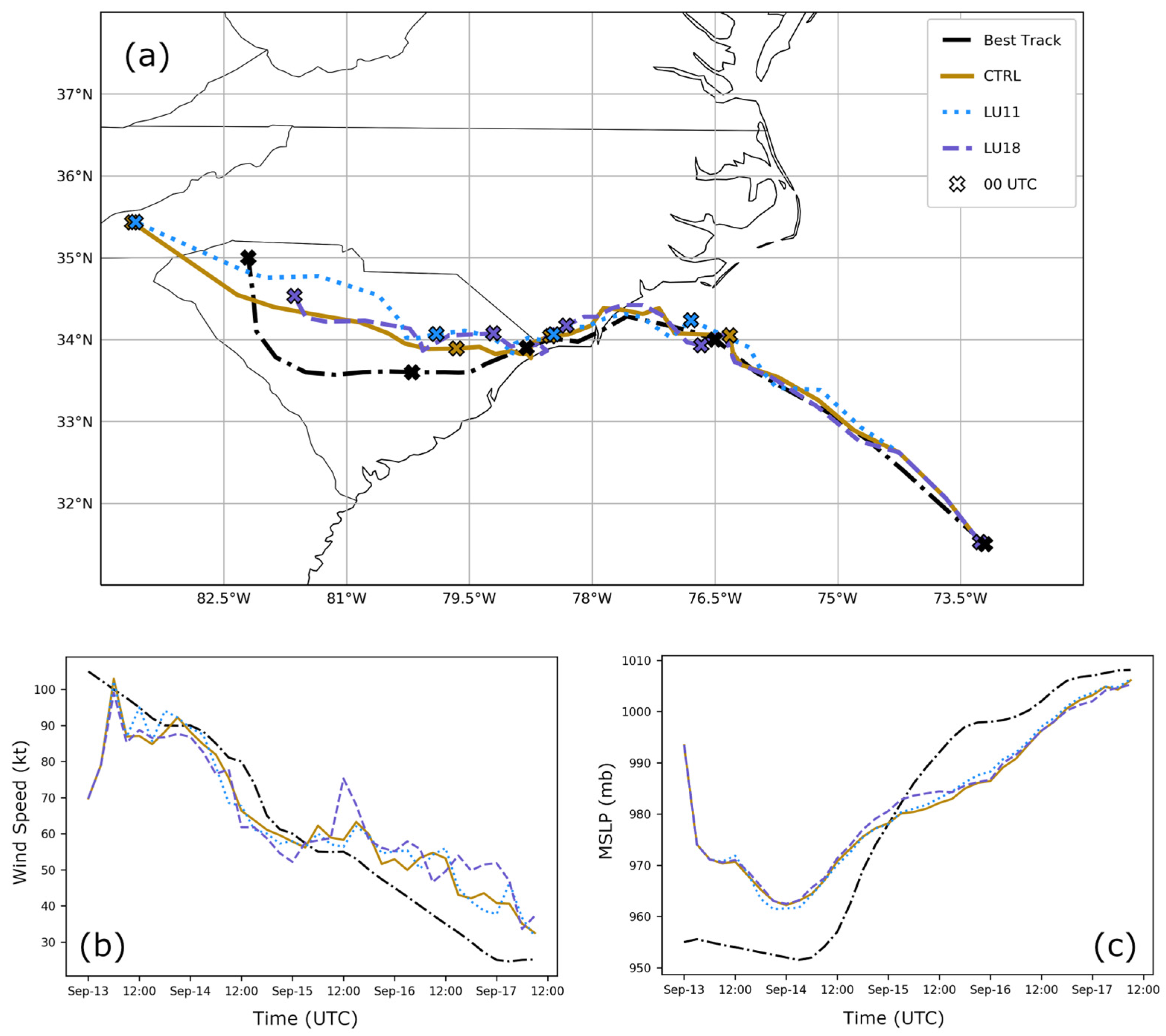
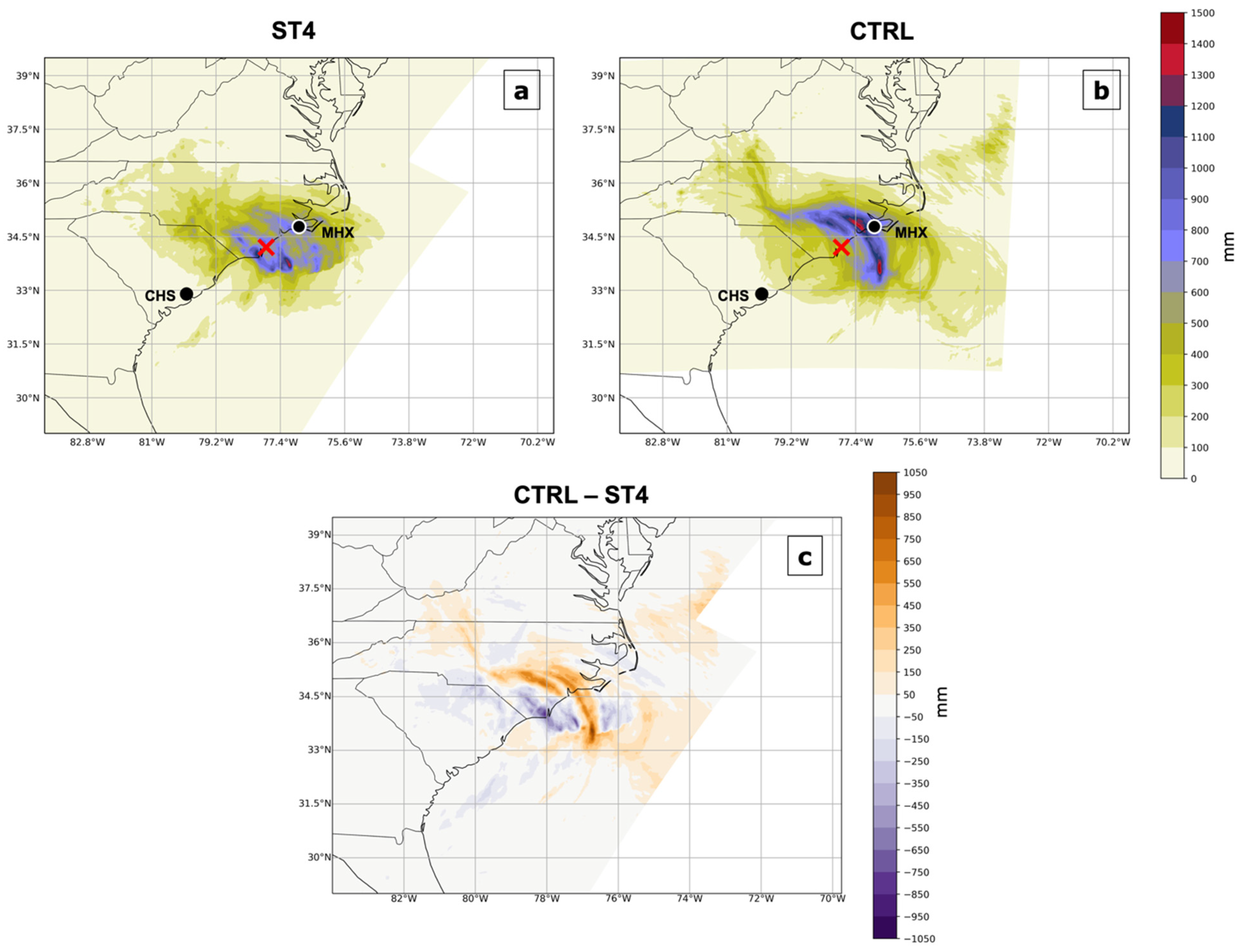
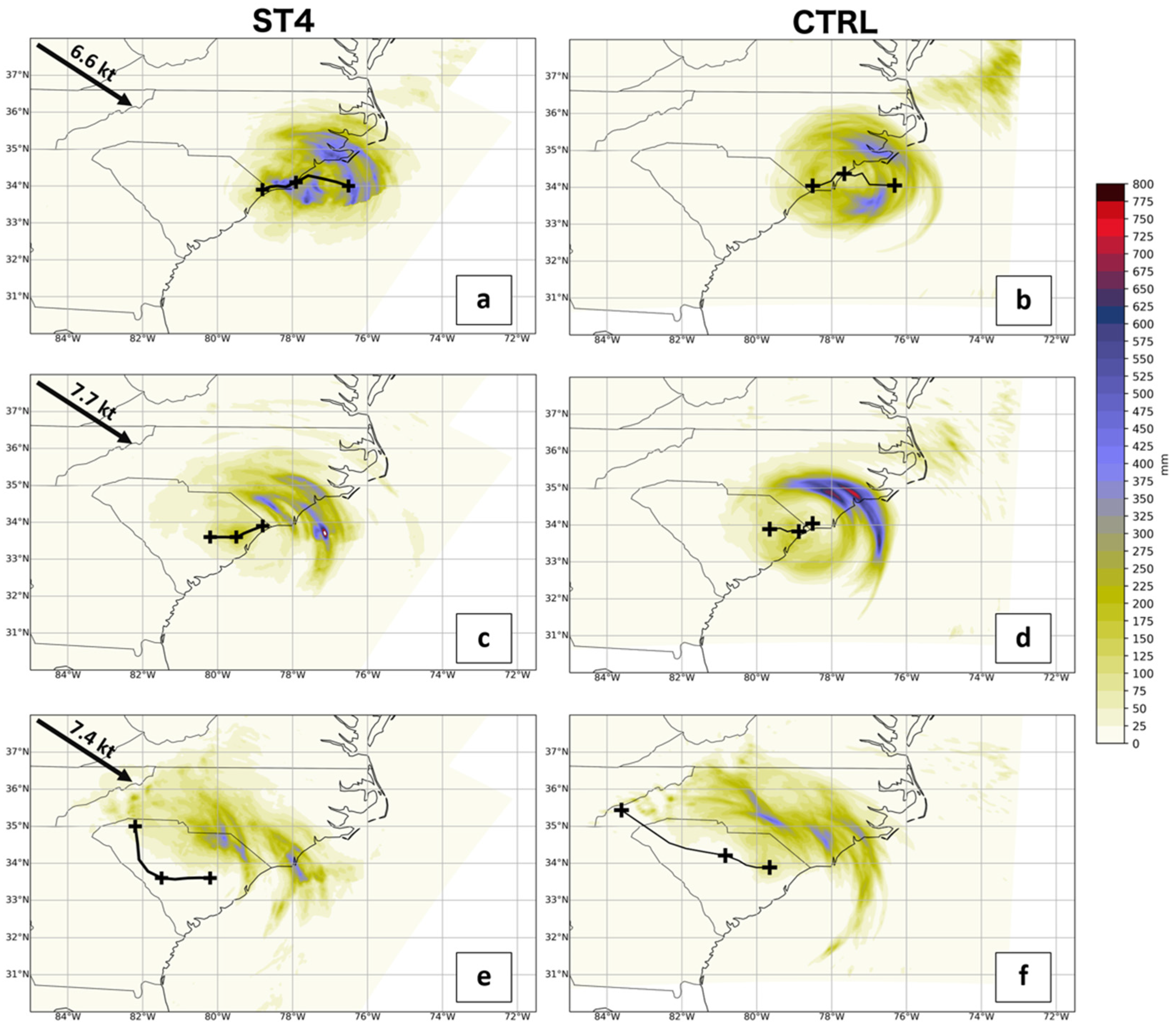
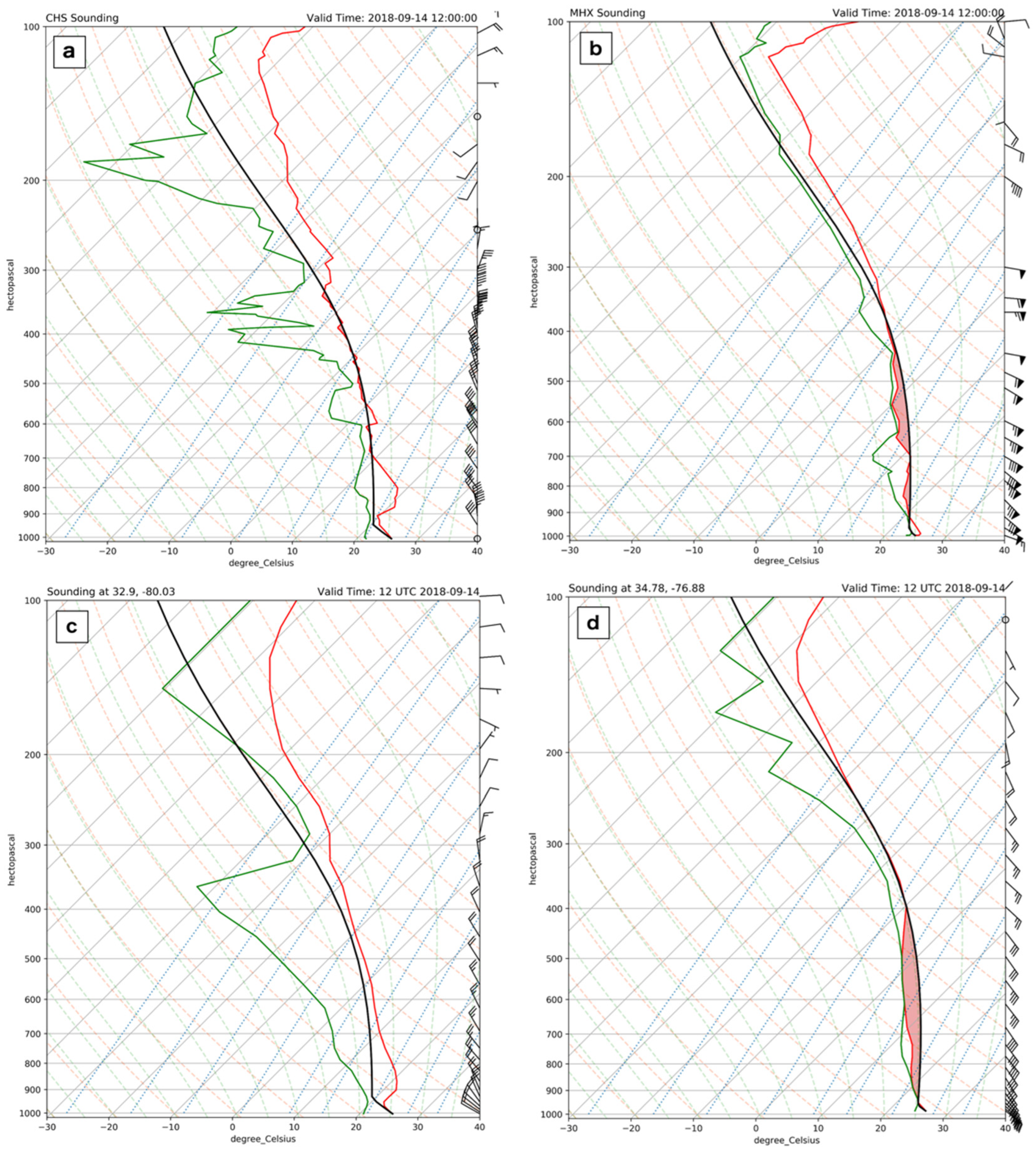
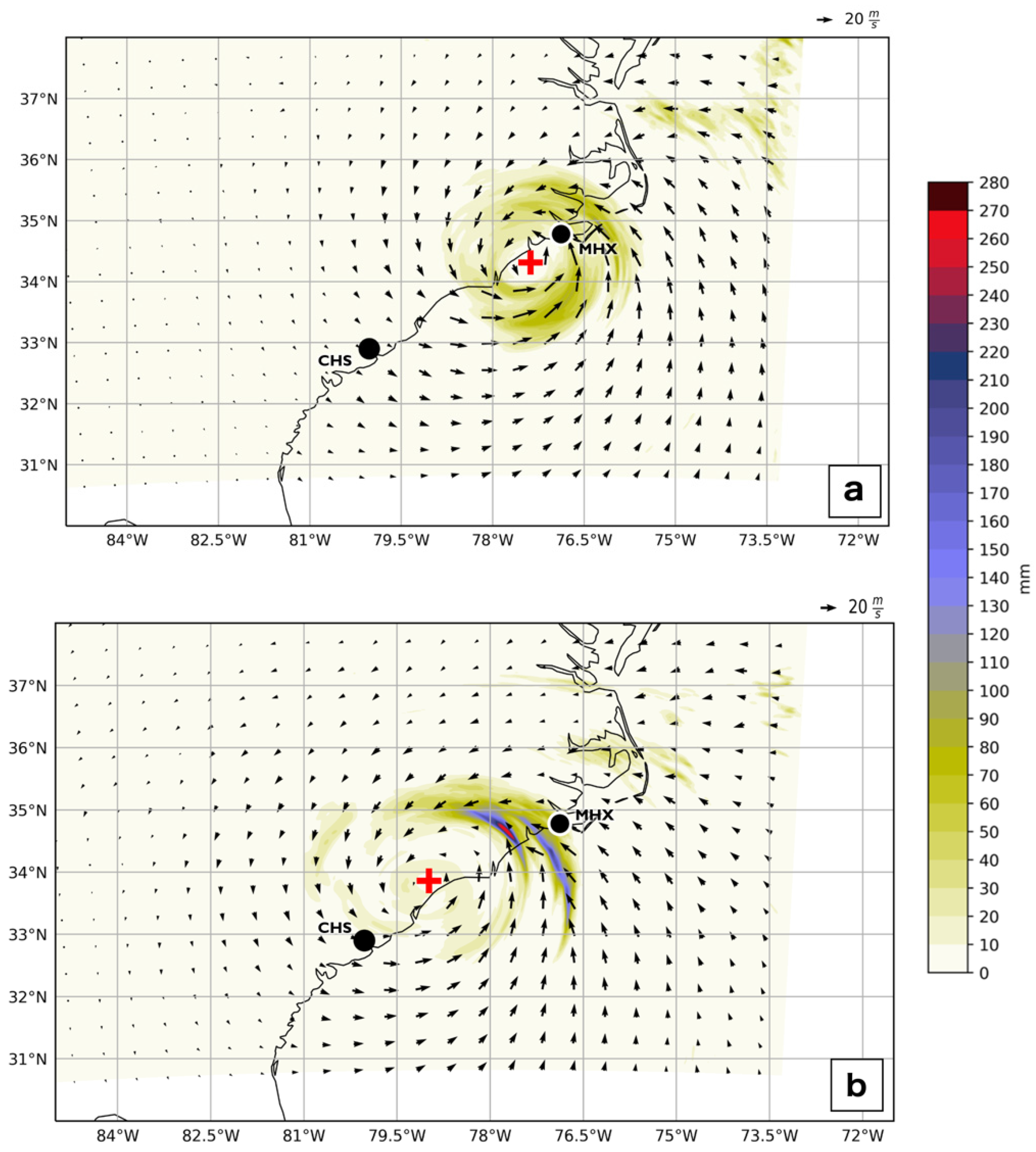


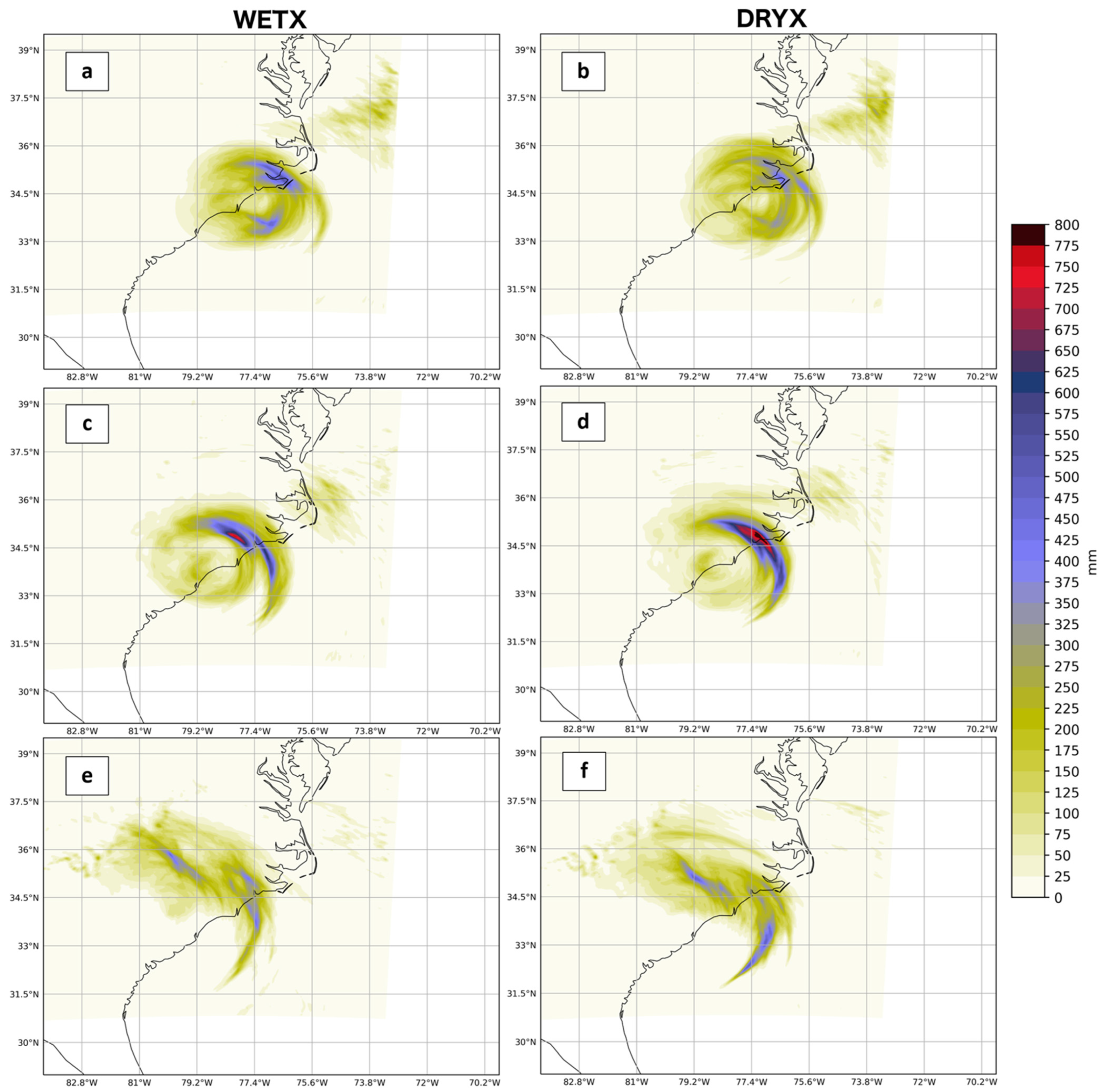
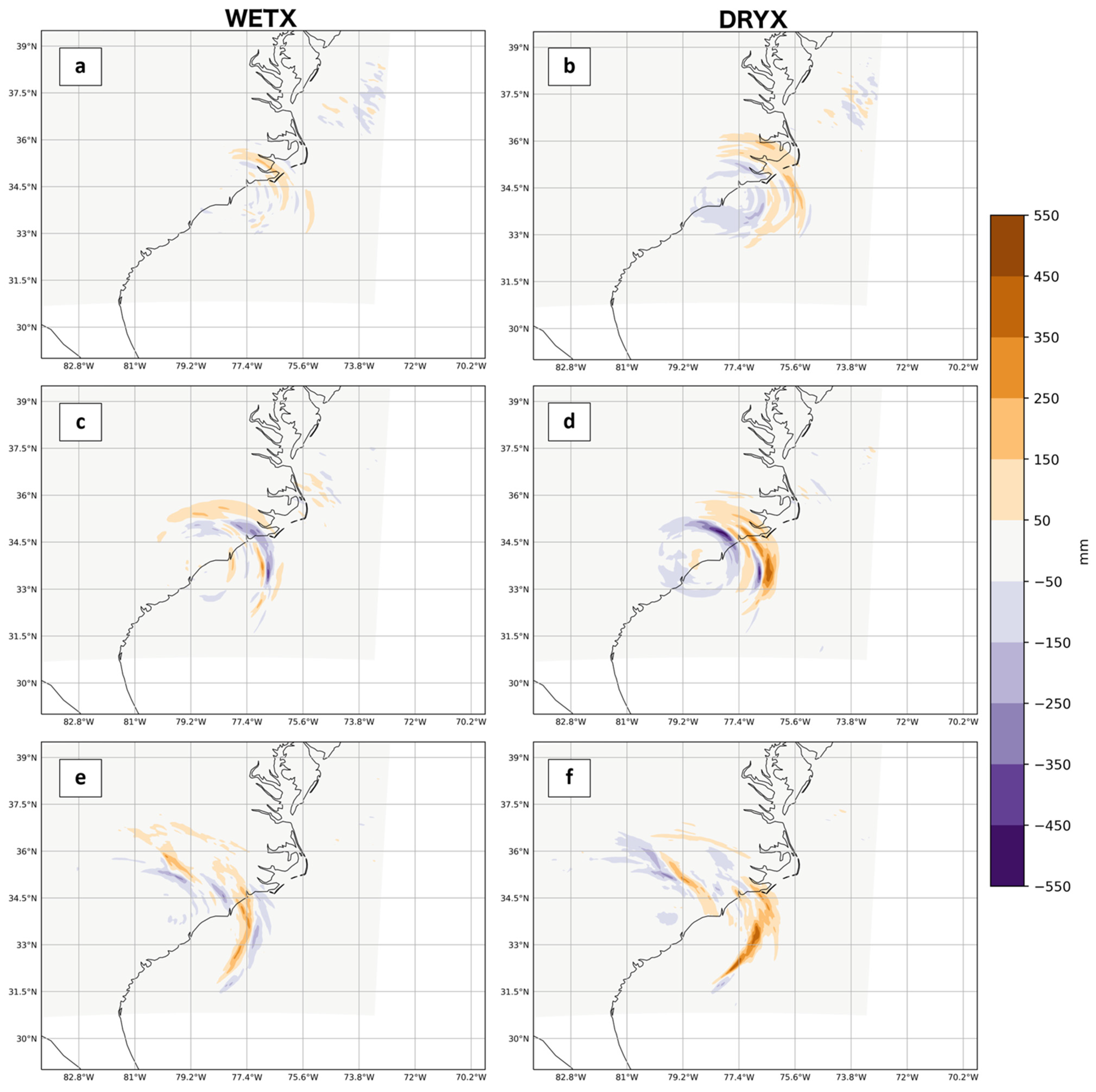
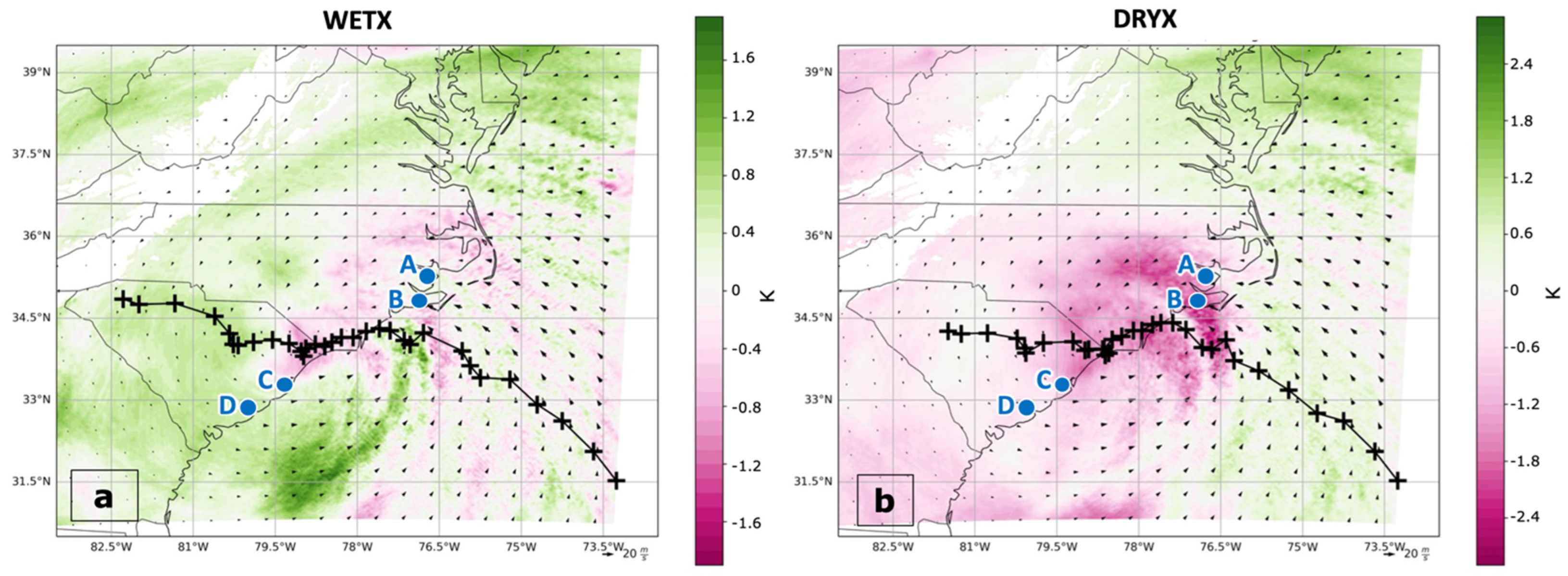
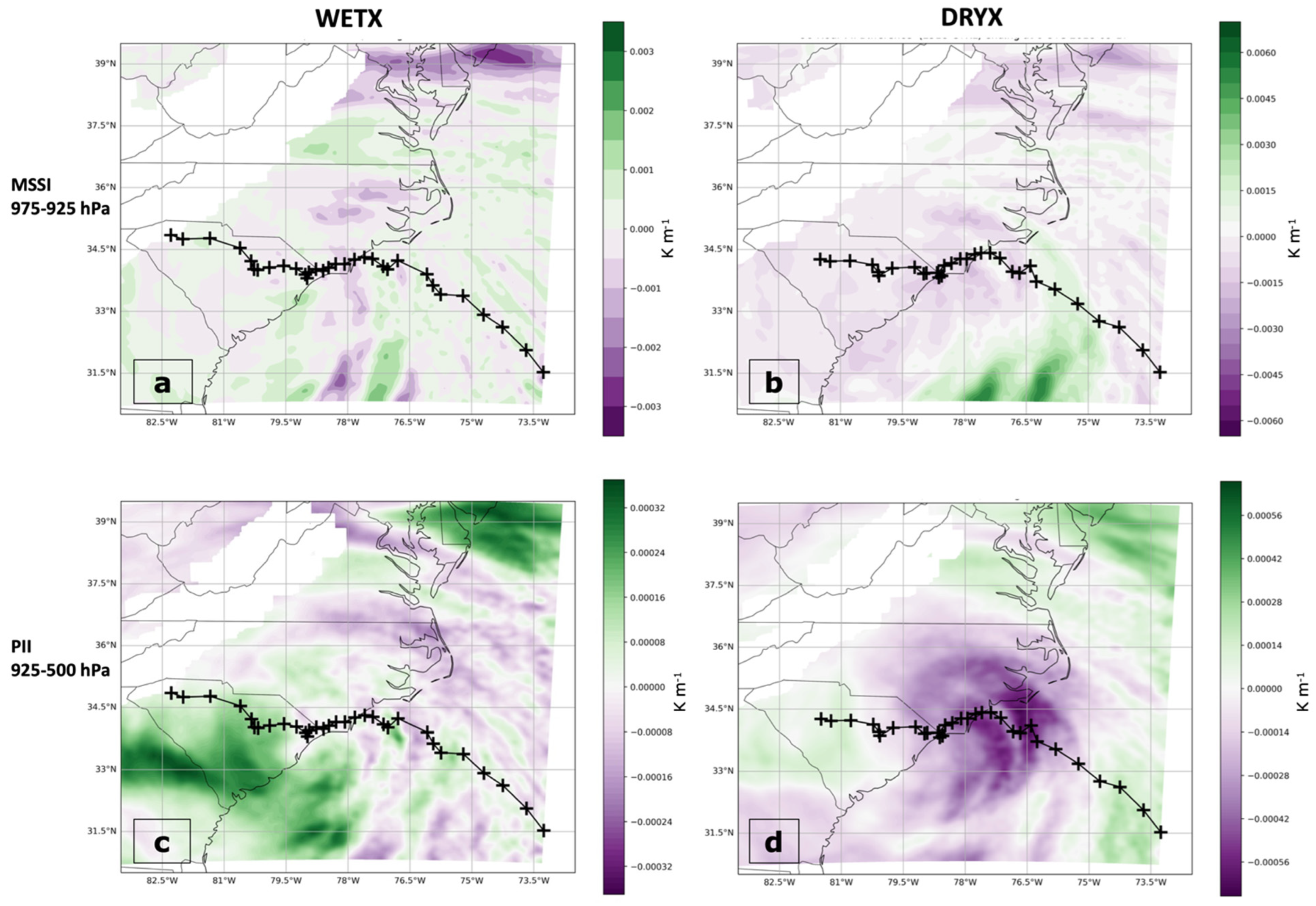
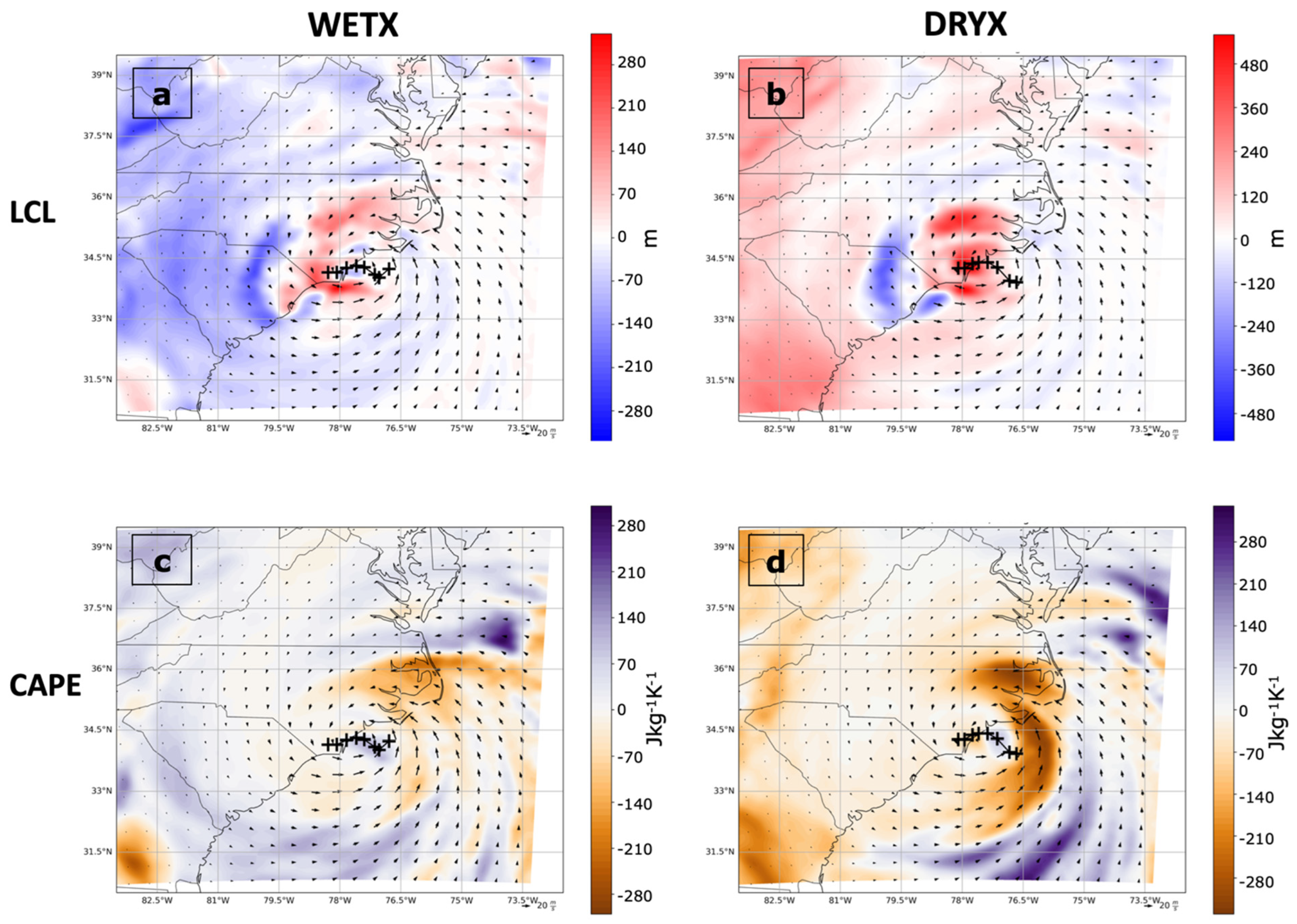
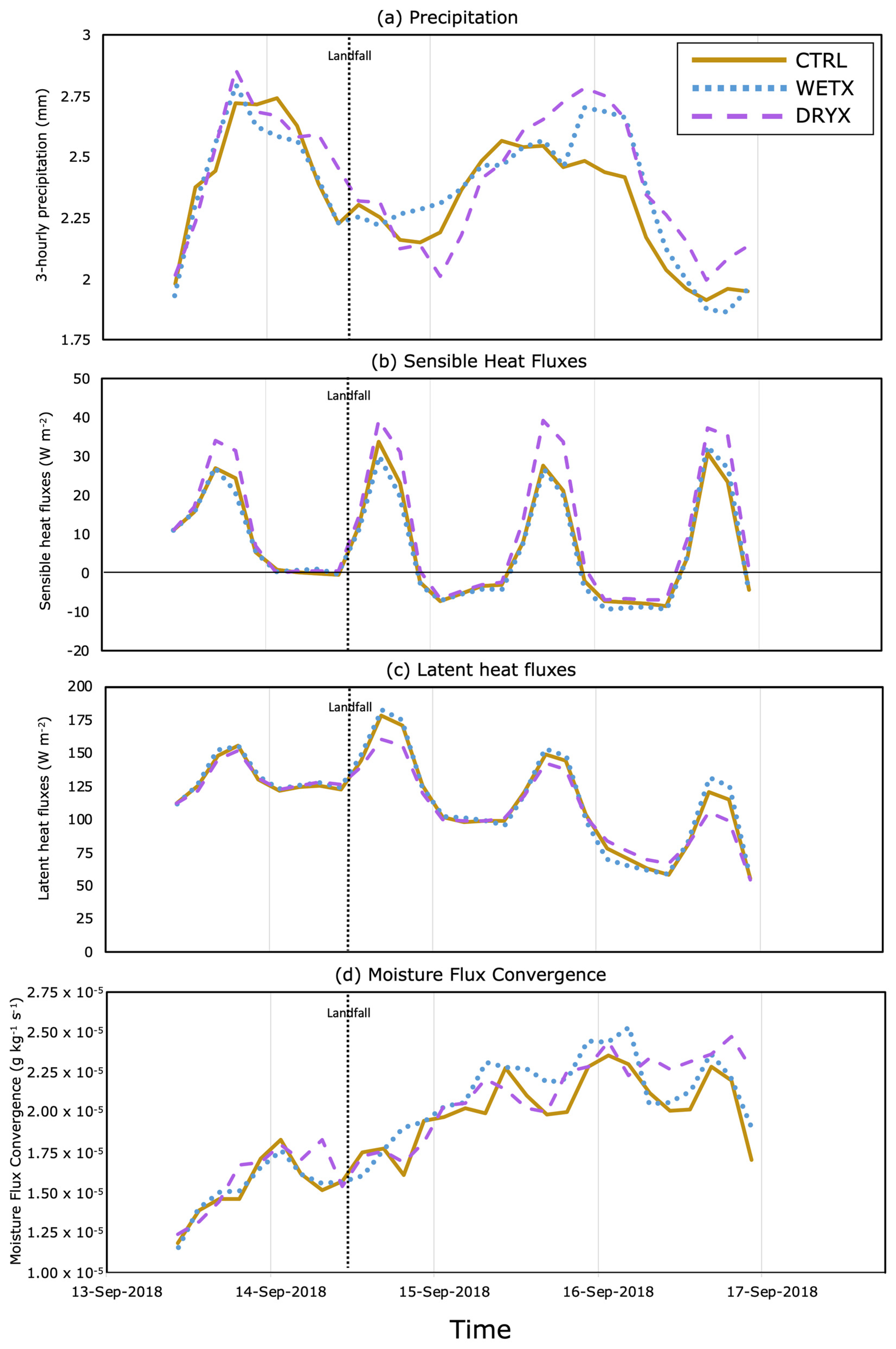
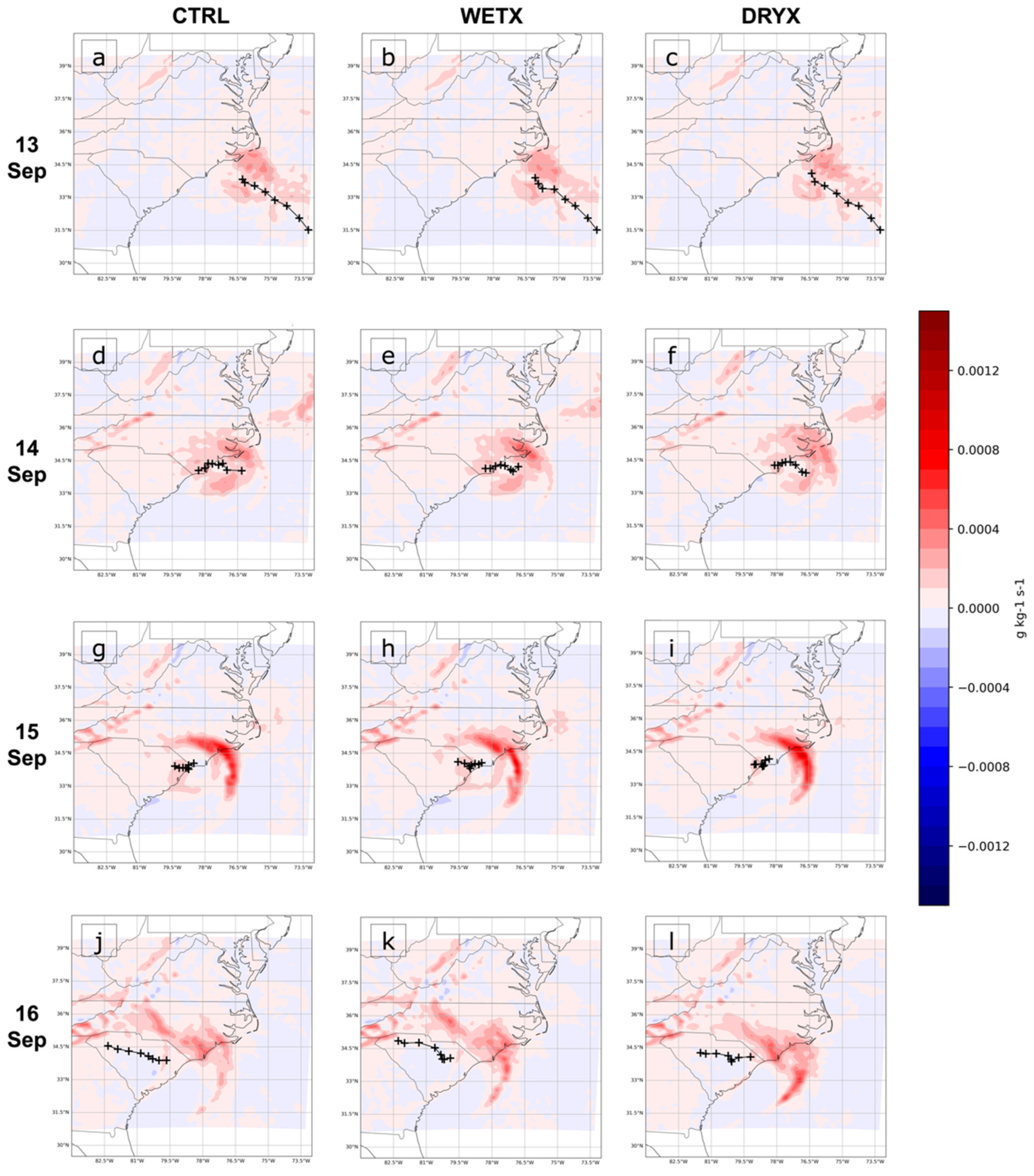
| Physical Parameterization | WRF-ARW v. 3.6.1 Option |
|---|---|
| Cumulus | Kain-Fritsch (18-km domain only) |
| Microphysics | WRF single-moment 6-class (WSM6) |
| Longwave Radiation | Rapid Radiative Transfer Model |
| Shortwave Radiation | Rapid Radiative Transfer Model |
| Planetary Boundary Layer | Yonsei University |
| Surface Layer | Revised MM5 surface layer scheme |
| Land Surface | Noah Land Surface Model |
| Land Use Index | Count | Percentage | Z0,min (m) | Z0,max (m) | HS |
|---|---|---|---|---|---|
| 1-Evergreen Needleleaf Forest | 7413 | 15.97 | 0.5 | 0.5 | 47.35 |
| 2-Evergreen Broadleaf Forest | 2702 | 5.82 | 0.5 | 0.5 | 41.69 |
| 3-Deciduous Needleleaf Forest | 1 | 0.00 | 0.5 | 0.5 | 47.35 |
| 4-Deciduous Broadleaf Forest | 2508 | 5.40 | 0.5 | 0.5 | 54.53 |
| 5-Mixed Forests | 5268 | 11.35 | 0.2 | 0.5 | 51.93 |
| 6-Closed Shrublands | 99 | 0.21 | 0.01 | 0.05 | 42 |
| 7-Open Shrublands | 6708 | 14.45 | 0.01 | 0.06 | 39.18 |
| 8-Woody Savannas | 1258 | 2.71 | 0.01 | 0.05 | 42 |
| 9-Savannas | 286 | 0.62 | 0.15 | 0.15 | 54.53 |
| 10-Grasslands | 8746 | 18.84 | 0.1 | 0.12 | 36.35 |
| 11-Permanent wetlands | 24 | 0.05 | 0.3 | 0.3 | 55.97 |
| 12-Croplands | 6552 | 14.12 | 0.05 | 0.15 | 36.25 |
| 13-Urban and Built-Up | 455 | 0.98 | 0.5 | 0.5 | 999 |
| 14-Cropland/natural vegetation mosaic | 3098 | 6.67 | 0.05 | 0.14 | 36.25 |
| 15-Snow and Ice | 1 | 0.00 | 0.001 | 0.001 | 999 |
| 16-Barren or Sparsely Vegetated | 373 | 0.80 | 0.01 | 0.01 | 999 |
| 17-Water Bodies | 0 | 0.00 | 0.0001 | 0.0001 | 51.75 |
| 18-Wooded Tundra | 886 | 1.91 | 0.3 | 0.3 | 42 |
| 19-Mixed Tundra | 40 | 0.09 | 0.15 | 0.15 | 42 |
| 20-Barren Tundra | 0 | 0.00 | 0.05 | 0.1 | 42 |
| Experiment | Z0,min (m) | Z0,max (m) | HS (Moisture) |
|---|---|---|---|
| CTRL | 0.27 | 0.35 | 46.44 |
| WETX | 0.30 | 0.30 | 55.97 |
| DRYX | 0.30 | 0.30 | 42.00 |
| Mid-Level Vertical Wind Shear | Magnitude (Knots) | Heading (Degrees) | Summary |
|---|---|---|---|
| 14 September | 6.6 | 112.5 | Weak, northwesterly |
| 15 September | 7.7 | 121.25 | Weak, northwesterly |
| 16 September | 7.4 | 104 | Weak, northwesterly |
| Charleston, SC (CHS) (Left of Track) | Newport, NC (MHX) (Right of Track) | |||
|---|---|---|---|---|
| Time | Observed | CTRL | Observed | CTRL |
| 00 UTC 14 September 2018 | 633.97 | 277.89 | 205.39 | 0.00 |
| 12 UTC 14 September 2018 | 6.82 | 0.00 | 226.42 | 416.57 |
| 00 UTC 15 September 2018 | 120.39 | 0.00 | 380.43 | 794.48 |
| 12 UTC 15 September 2018 | 3.48 | 0.01 | 694.04 | 1214.78 |
| 00 UTC 16 September 2018 | 102.28 | 0.90 | 762.23 | 1357.15 |
| 12 UTC 16 September 2018 | 107.70 | 0.00 | 570.90 | 1347.26 |
| Average | 162.44 | 46.47 | 473.24 | 855.04 |
| CTRL | WETX | DRYX | ||||
|---|---|---|---|---|---|---|
| Time | Left | Right | Left | Right | Left | Right |
| 14 September | 58.21 | 433.77 | 57.55 | 510.44 | 43.60 | 444.29 |
| 15 September | 4.40 | 870.87 | 17.69 | 847.63 | 6.60 | 535.82 |
| 16 September | 191.40 | 1081.57 | 240.47 | 1188.44 | 53.48 | 578.25 |
| Mean | 84.67 | 795.40 | 105.23 | 857.84 | 34.56 | 519.45 |
| Median | 2.44 | 771.46 | 6.59 | 810.39 | 4.07 | 433.09 |
| Deep Layer Shear | SHIPS | CTRL | WETX | DRYX |
|---|---|---|---|---|
| 13 September | 10.65 kts SSW | 8.21 kts SSW | 7.01 kts SSW | 7.15 kts SSW |
| 14 September | 14.33 kts WSW | 9.61 kts WSW | 11.84 kts WSW | 12.16 kts WSW |
| 15 September | 13.63 kts W | 16.54 kts W | 16.37 kts W | 17.47 kts W |
| 16 September | 12.50 kts W | 12.84 kts W | 13.23 kts W | 17.51 kts W |
Disclaimer/Publisher’s Note: The statements, opinions and data contained in all publications are solely those of the individual author(s) and contributor(s) and not of MDPI and/or the editor(s). MDPI and/or the editor(s) disclaim responsibility for any injury to people or property resulting from any ideas, methods, instructions or products referred to in the content. |
© 2023 by the authors. Licensee MDPI, Basel, Switzerland. This article is an open access article distributed under the terms and conditions of the Creative Commons Attribution (CC BY) license (https://creativecommons.org/licenses/by/4.0/).
Share and Cite
Rosenthal, L.; Zick, S.E. Evaluating the Role of Land Surface Moisture in Generating Asymmetrical Precipitation during the Landfall of Hurricane Florence (2018). Atmosphere 2023, 14, 814. https://doi.org/10.3390/atmos14050814
Rosenthal L, Zick SE. Evaluating the Role of Land Surface Moisture in Generating Asymmetrical Precipitation during the Landfall of Hurricane Florence (2018). Atmosphere. 2023; 14(5):814. https://doi.org/10.3390/atmos14050814
Chicago/Turabian StyleRosenthal, Lindsey, and Stephanie E. Zick. 2023. "Evaluating the Role of Land Surface Moisture in Generating Asymmetrical Precipitation during the Landfall of Hurricane Florence (2018)" Atmosphere 14, no. 5: 814. https://doi.org/10.3390/atmos14050814
APA StyleRosenthal, L., & Zick, S. E. (2023). Evaluating the Role of Land Surface Moisture in Generating Asymmetrical Precipitation during the Landfall of Hurricane Florence (2018). Atmosphere, 14(5), 814. https://doi.org/10.3390/atmos14050814






